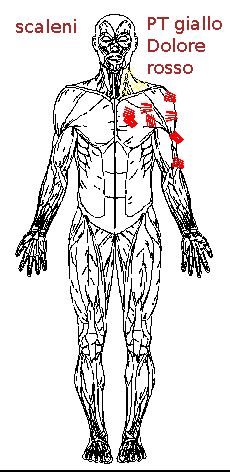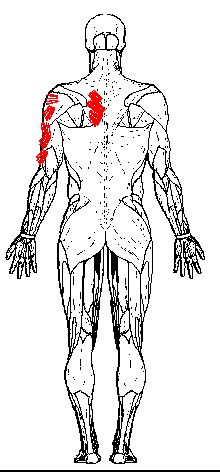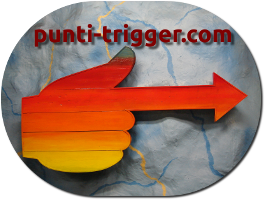The Scalenes are among the most important muscles for the serious Trigger Point practitioner to know. They are not easy to understand and treat, but because of their importance, it is essential to become well acquainted with them.
Anatomy
The Scalene group consists of Anterior Scalene, Middle Scalene and Posterior Scalene. In a small number of individuals, a fourth Scalene is present called Scalenus Minimus.
The Scalenes originate from the Cervical Tubercles and insert to the first and second rib. They surround the Thoracic Outlet which includes the Subclavian Vein and Arthery, and the Brachial Plexus.

Symptoms
Scalene trigger points cause an extended variety of symptoms which include referred pain, neurological dysfunctions, lymphatic and circulatory disfunctions, and mechanical-motor disfunctions.
The referred pain extends anteriorly to the chest, shoulder, Biceps, forearm and fingers. It extends posteriourly to the shoulder, Triceps and the area between the Scapula and the spine. There can also be pain and stiffness in the neck.
Because chest pain similar to that caused by the left SCalenes can also be a symptom of serious cardiac conditions, such possibility must always be ruled out.
Scalene taut bands can also cause the Thoracic Outlet Syndrome condition, which consists of the compression of the nerves of the Brachial Plexus and of the Subclavian blood vessels, with hand tingling, weakness and pain, and hand puffiness and swelling.
In summary therefore the Scalene trigger points can cause a broad spectrum of symptoms which are not easy to interpret and which can therefore cause a series of erroneous diagnoses.


Treatment
In order to treat Scalene trigger points, it is fundamental to become well acquainted with the anatomy of these muscles. It is important to study the anatomy table and to become familiar with the several structures of the neck area as well as with the direction of the muscle fibers of the Scalene and adjacent muscles.
Scalene muscles are among the hardest to self massage. One can use an instrument such as the Theracane over a layer of clothing for self-treatment.
To treat a patient, the best way is to have the patient supine on the massage table while the therapist sits close to the head of the patient. The head of the patient is then turned toward the side opposite to the Scalene to be treated. In this way, the Sternocleidomastoid can be pushed aside and te thumb or fingers can contact the underliying Scalenes and explore for trigger points by pressing aanst the underlying cervical vertebrae.
Because Scalene trigger points can occur anywhere in the muscle, is is important to explore also the area behind the Clavicle.
Scalene trigger point massage can be painful and intense, so it is best not to prolong excessively the session and to proceed gradually. However, the benefits will be apparent after just a single short session and the patient often is surprised to experience pain at great distance from the area being massaged. Scalene trigger point massage is a very convincing proof of the reality of trigger point referred pain.
A self-stretch routine can be adopted by sitting on a chair, grasping the edge of the chair with the involved side, grasping the top of the head with the hand of the opposite side, and with this hand gently pulling toward the opposite side.
Moreover, each of the three Scalenes can be focused on by rotating the head on its axis: the posterior Scalene is stretched by rotating the head toward the opposite side, the middle Scalene by looking ahead, and the anterior Scalene by rotating the head toward the affected side.
Note: always stretch both sides for symmetry.



Perpetuating factors
Because the functions of the Scalenes are neck stabilization and respiration, the factors that contribute to Scalene trigger points can be both related to muscular overuse both chronic or acute such as pushing, computer work, or car accidents, and to paradoxucal respiration such as breathing with the upper chest instead of using the diaphragm.
Moreover, Scalene trigger points are exceedingy sensitive to cold temperatures and drafts. It is very important to keep the neck area warm by using e.g. a scarf when in cold and windy climates.
